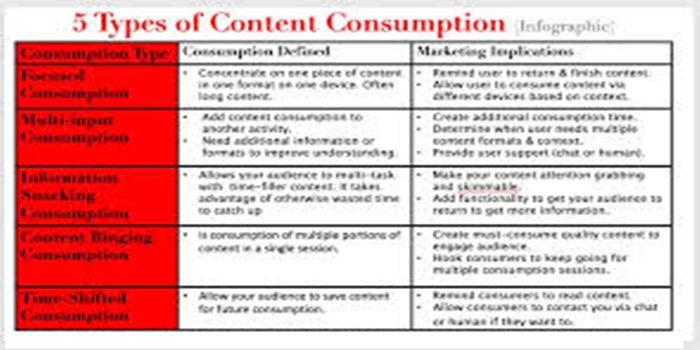In this post, we explained the meaning of content consumption, the types, the examples, and we also talked about the importance.
Definition
Content consumption refers to the process of how individuals engage with and interact with various forms of media and information. This includes reading, watching, listening, or scrolling through content like articles, videos, podcasts, and social media feeds. Essentially, it’s the way people absorb and interact with digital content.
Content consumption can be broadly categorized into several types based on the format of the content, how it’s consumed, and the level of engagement it involves.
The Types of Content Consumption:
- By Format:
Visual Content:
This includes videos, images, infographics, and other visual formats that are quickly consumed and can convey complex information in a digestible way.
Auditory Content:
Podcasts, audiobooks, and other audio formats allow for multitasking and are often consumed passively while driving or exercising.
Written Content:
Articles, blogs, ebooks, and other text-based content require more focus but can provide in-depth knowledge.
Interactive Content:
This includes games, simulations, and other forms of media that allow users to actively participate in the content.
- By Engagement:
Focused Content Consumption:
This involves a high level of engagement and attention to the content, such as reading a book or watching a movie.
Multi-Input Content Consumption:
This involves consuming content while also multitasking, such as listening to a podcast while driving or reading an article while working.
Information Snacking Consumption:
This involves consuming small pieces of information quickly, like scrolling through social media or reading short blog posts.
Content Binging:
This involves consuming large amounts of content in a short period of time, such as watching multiple episodes of a TV show in a row.
Time-Shifted Content:
This involves consuming content that was originally produced and broadcast at a different time, like watching a recorded TV show or listening to a podcast that was recorded earlier.
- Other Categories:
Social Content:
Content consumed on social media platforms, often semi-passively or actively with likes, comments, and shares.
Conversational Content:
Content consumed through one-on-one or group communication, such as phone calls, text messages, or online chats.
Digital Content:
Any type of content consumed online, including blog posts, videos, audio, and interactive media.
Media Consumption:
This encompasses a broad range of activities, including interacting with new media, reading books and magazines, watching television and film, and listening to radio, according to Wikipedia.
- Content Formats:
Text: Articles, blogs, ebooks, and other written content.
Visuals: Images, infographics, charts, and other visual aids.
Video: Online videos, webinars, and live streams.
Audio/Voice: Podcasts, audiobooks, and other audio formats.
Understanding these different types of content consumption can help marketers and content creators tailor their content and strategies to better engage their audience, according to Heidi Cohen.
Content Consumption Examples include:
Reading: News articles, blog posts, ebooks, magazines, and academic papers.
Watching: Television shows, movies, online videos (YouTube, Netflix, etc.), live streams, and social media videos.
Listening: Podcasts, audiobooks, music streaming services, and radio broadcasts.
Engaging with social media: Scrolling through feeds, commenting on posts, sharing content, and participating in online communities.
Interactive Content: Playing online games, completing quizzes, and interacting with interactive web pages.
Informative Content: Websites, articles, and videos that aim to educate or inform the audience on a particular topic.
Entertaining Content: Content designed to amuse or entertain the audience, such as movies, TV shows, and games.
Content that inspires emotional response: Content that aims to evoke strong feelings in the audience, such as stories, advertisements, and news reports.
Why Content Consumption is Important:
- Learning and Personal Growth:
Acquiring Knowledge:
Consuming diverse content exposes us to new ideas and perspectives, enriching our understanding and fostering personal growth.
Skill Development:
Engaging with content, especially educational materials, can enhance skills and knowledge retention.
Motivation and Problem-Solving:
Content that resonates with us can boost motivation and improve problem-solving abilities.
- Shaping Perspectives and Well-being:
Influencing Beliefs:
The content we consume shapes our perspectives, influencing our views on various topics.
Impact on Mental Health:
Our mental health can be affected by the type and amount of content we consume.
Healthy Consumption Habits:
Being aware of our consumption habits can lead to better productivity and overall well-being.
- Business and Marketing Applications:
Increased Brand Awareness:
Engaging content can help brands reach a wider audience and build awareness.
Improved Customer Engagement:
Quality content can drive engagement, leading to increased leads and sales.
Demonstrating Expertise:
Content can help businesses establish their expertise and differentiate themselves from competitors.
- The Content Consumption Cycle:
Content Strategy:
Understanding the content consumption cycle is crucial for effective content marketing.
Targeted Audience:
A well-crafted content strategy can help businesses reach their target audience more effectively.
Content Types:
Different types of content (e.g., blog posts, videos, social media posts) cater to different stages of the content consumption cycle.
- Personal Development and Well-being:
Mindfulness:
Being mindful of our content consumption habits can help us avoid excessive screen time and negative content.
Positive Engagement:
Choosing content that is positive and engaging can have a positive impact on our mental health.
Productivity:
Managing our content consumption can lead to increased productivity and focus.
Conclusion
Content consumption, is the act of engaging with and absorbing various forms of media, is important for learning, personal development, and overall well-being. It influences our perspectives, mental health, and even our buying decisions. Understanding how we consume content and being mindful of the content we consume can lead to a more fulfilling and productive life.


